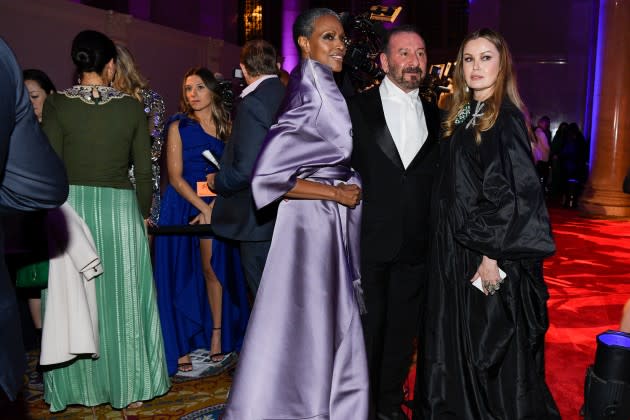Ralph Rucci Searching for Select Designs and Archival Material
- Oops!Something went wrong.Please try again later.

Just as long-running designers can have multiple incarnations, so, too, can their creations.
Those multiple lives, however, can be left wide open to interpretation, appropriation, secondhand markets and retailers. One such alleged scenario has been brought forward by Ralph Rucci, who posted on Instagram about his ongoing search to retrieve some of the clothes that he designed and some archival material
More from WWD
The designer first put the word out via Instagram on Tuesday with a striking image of a sculptural purple gown. He clued in ”important friends” that it has come to his understanding that his archives have been sold or disbursed previously through — “GET READY — CENTURY 21. SAY NOT ONE WORD. JUST READ.”
Rucci said he was actively pursuing the buy-back of any archival materials – clothes, files, sketches, books…”ANYTHING!!!!! THAT ANYONE HAS PURCHASED OR RECEIVED.” By his account, thousands of first patterns from 1981 to 2015 were destroyed. The post continued, ”(THE EVIL IS UNIMAGINABLE.)” Rucci urged anyone with any information or with anything that he might purchase, to please DM him.
Having worked in the fashion industry for more than 40 years, Rucci has soldiered on for most of that time as an independent designer. However, he took on financial investors at one point and in November 2014 exited the namesake company that he founded. Two years earlier Nancy and Howard Marks had made a capital investment in Rucci, becoming the company’s chairman and a board member, respectively.
The designer started his company with a $10,000 loan from an aunt and made a name for himself with highly detailed and sophisticated clothes that attracted clients like Deeda Blair, Martha Stewart and Whoopi Goldberg. His accolades included having become the first American after Mainbocher to have been accepted by the Chambre Syndicale de la Haute Couture to be accepted to show haute couture under his own label in Paris.
On Wednesday, Rucci declined an interview but issued the following statement, ”I recently became aware that many clothes and other archival materials conceived and created by me were being sold by unauthorized retailers, including Century 21 and possibly overseas from 2014 until the present.”
Century 21 said that unfortunately it does not have any records or recollection to help corroborate this, according to a spokesperson.
Rucci’s statement Wednesday indicated that he had reached out to social media followers in “an effort to protect his reputation and legacy,” and declined any further comment. The designer has 19,500 followers on Instagram. As of Wednesday, the Tuesday afternoon post that flagged his concern had 1,130 likes and 101 comments.
Speculating about such situations, New York University law professor Chris Sprigman said the basic question comes down to who owns the archives, adding that the fact that Rucci didn’t have them in his possession suggests he doesn’t own them.
The designer and a company spokesperson, as well as his lawyer, did not acknowledge requests to address that Wednesday.
Rucci’s search and allegations stir up issues that generations of designers have dealt with. ”Fashion designs themselves are only peripherally copyrighted. You can get a copyright on a fabric pattern, or on a drawing or an illustration on a T-shirt. You can’t generally get a copyright on a fashion design as such,” Sprigman said. ”On the other hand, drawings of fashion designs, sketches or photographs are copyrighted as drawings and photographs. You can’t just copyright any article of clothing that you need to pitch. In a lot of instances, you can copyright in the drawings and the photographs. For a transfer of copyright ownership to take place, if the copyright is initially owned by the ’author’ – the person, who typically did the drawing or the photograph, but not always.”
The law professor noted that sometimes if the person doing the drawing or the photograph is an employee working within the scope of their employment, the employer is considered the author as well as the copyright owner, not the person, who actually made the drawing or took the photograph. That could apply even if the creator were the chief executive officer, Sprigman, who is co-author of ”The Knockoff Economy,” said. ”Even if he owns the copyright, he may have assigned it to the company or the investors. The assignment has to be in writing.”
In the event a designer’s sketches wind up with a retailer, probably nothing will happen legally “unless the sketches had been copyrighted and the retailer runs off a bunch of copies of the sketch that are given to other designers to take a look at,” Sprigman said.
Should a designer’s sketches wind up with a retailer, that retailer could use those sketches as a base to create a new collection of dresses or whatever and there would not be be protection, he said. ”In general, fashion designs are not copyrightable. But again there are specific instances [where they are], for example with something to do with fabric pattern that is harder to design. Fabric patterns are copyrightable. You don’t have to register or anything. They are eligible,” Sprigman said.
In turn, If a designer goes to a shopping mall, sees a dress design they like, sketches it and then goes back to their atelier and produces it, that is not a copyright infringement in general. ”That of course is how the fashion industry has worked, since the 1940s. Before that, the fashion industry essentially had a cartel called the Fashion Originators Guild. But the U.S. government prosecuted that cartel for anti-trust violations. Since the fall of that cartel, the rule we have been living under is basically you are free to copyright fashion designs. Of course, we all know that’s exactly what happens. Part of my work is documenting how that helps the industry thrive.”
Sign up for WWD's Newsletter. For the latest news, follow us on Twitter, Facebook, and Instagram.
